Determination of Toxic Elements in Food by ICP-MS Using AOAC Method 2015.01
Trace elements can be taken up by crops and animals from the air, water, soil, and food during growth, or introduced during food processing. Although some of these elements are essential macronutrients, others are toxic. Through food consumption, humans are exposed to toxic elements with the risk increasing proportionately to the amount consumed, which can have neurological-, endocrine-, and exocrine-disrupting properties, as well as being potentially genotoxic or carcinogenic. As a result, the contamination of food and water by toxic elements is of great concern because concentrations can be present at trace to ultra-trace levels, requiring sensitive and reliable analytical techniques for accurate measurement. Inductively coupled plasma mass spectrometry (ICP-MS) is a powerful elemental analysis technique with multi-element detection capabilities, low detection limits, high speed of analysis, and wide linear dynamic range. However, it is also susceptible to interfering species, leading to the formation of polyatomic and doubly charged ions. Here, we evaluate the performance characteristics of ICP-MS to carry out the validation procedures and QC requirements defined in AOAC Method 2015.01.
Polyatomic interferences are generated by the reaction of matrix ions and plasma-based elements, such as Ar, C, N, O, and H, which can overlap target ions. Examples of such polyatomic interferences relevant to toxic-element analysis include 40Ar35Cl+ on 75As+, 95Mo16O+ on 111Cd+, 185W16O+ on 201Hg+, and so forth. Doubly-charged ions are formed by the secondary ionization of elements with low second-ionization potentials, such as rare earth elements (REEs). For example, the doubly-charged ions from 150Nd and 150Sm may interfere with 75As, resulting in a false overestimation of the result. Rare earth elements are not usually present in significant amounts in food samples, but with increased industrialization and globalization, food products can be sourced from geological regions with high REEs. As such, rare earth elements present in some food products should not be overlooked in elemental analyses.
All commercially available single quadrupole inductively coupled plasma–mass spectrometry (ICP-MS) systems are fitted with a collision/reaction cell (CRC) or collision/reaction interface (CRI), which either utilizes collision mode with kinetic energy discrimination (KED) or reaction mode with dynamic bandpass tuning (DBT) to mitigate interferences from polyatomic ions. The collision mode typically involves colliding both the analytes and interferences with an inert gas, usually helium. Because polyatomic interferences have a larger cross-sectional diameter than elemental ions at the same mass (for example, 95Mo16O+ is larger than 111Cd+), they undergo more collisions and lose more energy. Therefore, they cannot pass the energy barrier at the exit of the collision/reaction cell and are rejected from the ion beam. However, interferences from doubly-charged ions and isobars cannot be effectively resolved using collision mode. A few techniques have been developed to correct for these interferences, which can be either through post-analysis mathematical corrections or via the use of reaction gases. For doubly-charged ions, mathematical corrections using the half-mass approach (such as correction equations at higher resolution) are often not preferred because this comes at the expense of analyte sensitivity. A more effective means of removing these interferences is to use reaction gases where, in the case of As, it reacts with oxygen to form 75As16O+ at mass 91. Moving the analyte away by +16 amu from the respective doubly-charged interferents results in a lower detection limit without compromising analyte sensitivity.
Experimental
The Association of Official Analytical Collaboration (AOAC) International elemental analytical method AOAC 2015.01 (1) describes the analysis of toxic elements in food samples using ICP-MS. In this work, the analysis of toxic elements As, Cd, Hg, Pb, and Sb in various food matrices following AOAC 2015.01 was validated using the NexION ICP-MS (PerkinElmer Inc.) instrument fitted with a universal cell using both collision and reaction modes. The instrument was also equipped with a high throughput system (HTS) that utilized flow injection technology to deliver the sample to the plasma during the data acquisition stage and diverted the sample to the waste for the rest of the time. This reduces the total sample load on the plasma and results in less maintenance and downtime. Because the sample loading and loop wash were enabled by the vacuum pump, HTS can perform the wash procedure more efficiently than conventional sample introduction. Sample digestion was performed using a Titan MPS microwave digestion system (PerkinElmer Inc.). The instrument components and operating conditions used for the analysis are shown in Table I.
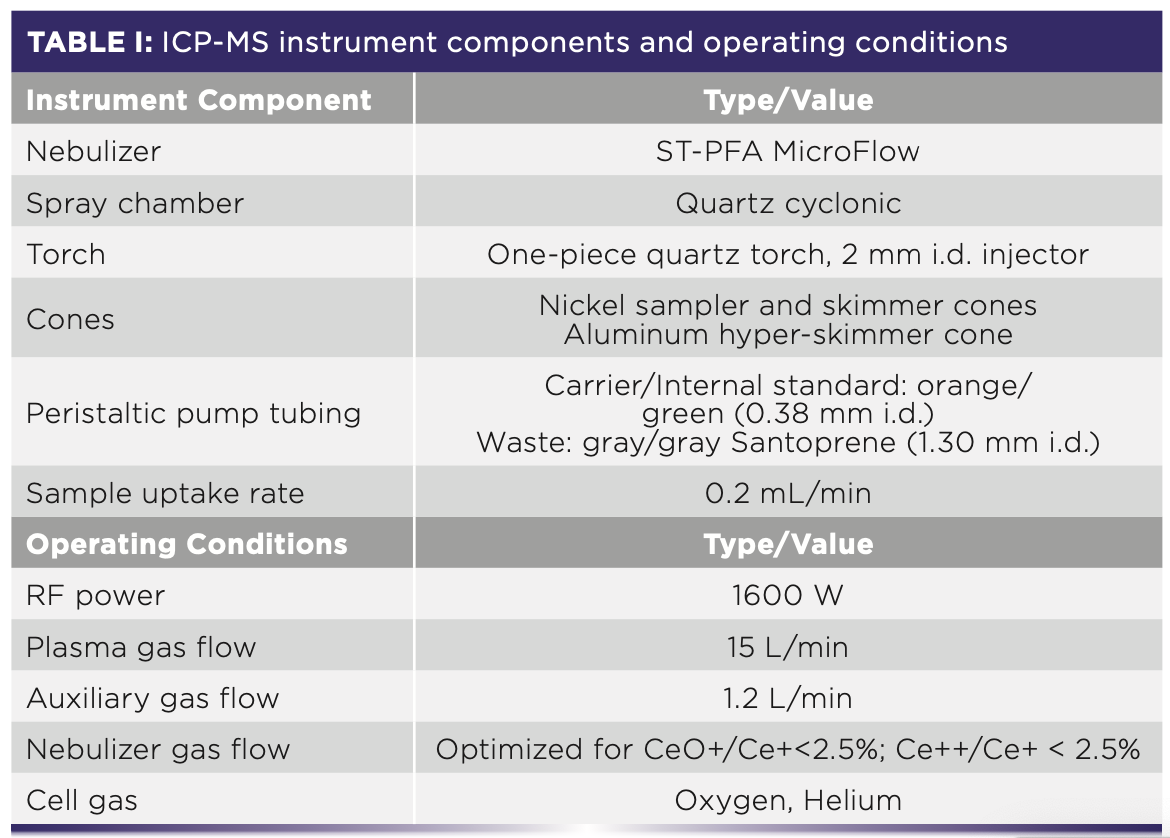
Instrument Optimization and Method Development
The elements being determined, their respective isotopes, and the mode of analysis used for each element in this method are listed in Table II. Cobalt, Mo, Zr, and W were monitored for interference evaluation. Among the analytes, As was measured as AsO in reaction (DRC) mode using oxygen as the cell gas, and the rest of the analytes were measured in collision (KED) mode using helium as the cell gas.
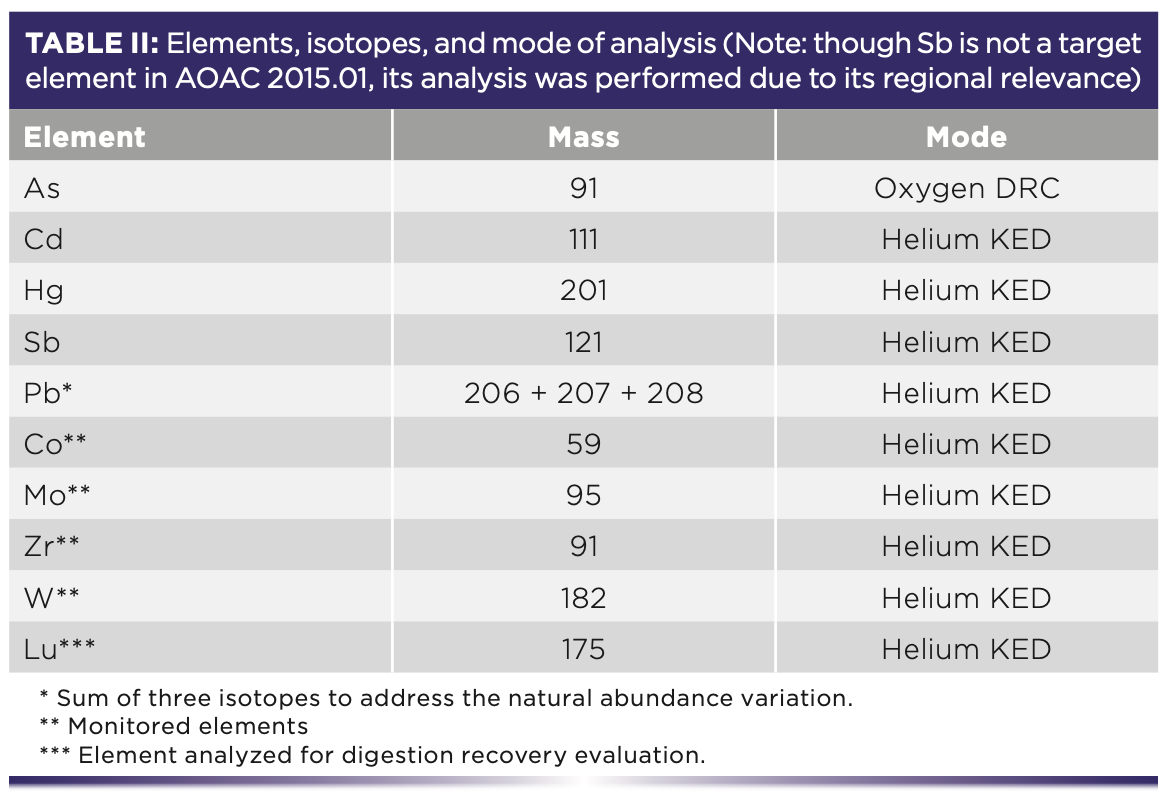
Reagents and Calibration Standards
Ultrapure water (UPW; 18.2 MΩ.cm) and high-purity acids (Tamapure, Tama Chemicals) were used throughout this work. The calibration standards were prepared by the dilution of ICP-MS grade multi-element standards in a diluent made of 5% HNO3 spiked with 200 ppb of Au to aid the mobility of Hg. This diluent was also used as the calibration blank and carrier solution. The concentrations of the calibration standards are shown in Table III. Standard 4 was also used as a continuing calibration verification (CCV) standard.

The internal standard solution was comprised of 40 ppb of Rh and Ir in a solution of 1% HNO3 and 4% isopropanol (IPA) and spiked with 200 ppb of Au. Isopropanol was added to compensate for the difference in the carbon content in the standards and the samples and among samples to address the carbon-induced signal enhancement effects on As (2,3). The internal standard was introduced into the designated port of the HTS valve and mixed online with the sample. The wash solution consisted of 1.5% HCl (v/v), 1.5% HNO3 (v/v), and 5% IPA, and it was spiked with 200 ppb Au where IPA was used to facilitate the washout of organic materials.
Interference Removal Checking Solutions
In this work, the interference from 59Co16O2+ and 91Zr+ on 91AsO+, 95Mo16O+ on 111Cd+, and 185W16O+ on 201Hg+ was evaluated using a series of single-element standard solutions of Co, Zr, Mo, and W, which were prepared in 3% HNO3 with concentrations of 10, 50, and 100 ppb each.
Sample Preparation
Three food certified reference materials—SRM 1568b (rice flour) and SRM 2976 (mussel tissues), purchased from the National Institute of Science and Technology (NIST), and DORM-5 (fish protein) purchased from National Research Council Canada—were used to validate the accuracy of the method. They were also used to evaluate the method precision (via method duplicates) and matrix spikes, in which the samples were spiked with multi-element standards to the concentrations of 1 ppb for As, Cd, Sb, and Pb, and 0.1 for Hg in the analytical solutions. For all food samples, lutetium (Lu) was added before digestion to assess the potential loss during digestion, as specified in AOAC 2015.01. Three method blanks were included in each digestion batch. The blanks were treated the same as the samples and went through all the preparative steps.
The digestion vessel was pre-wet by adding a few drops of ultrapure water (UPW). Food samples of ca. 0.5 g were accurately weighed, and then transferred into 75 mL microwave digestion vessels. Then, 1 mL of UPW was added, followed by 8 mL HNO3, 2 mL H2O2, and 0.1 mL of 100 mg/L Au and 100 mg/L Lu. The method blanks, samples, and matrix spikes were digested in the same batch using the built-in rice flour method. Microwave digestion parameters are shown in Table IV.

After digestion, the samples were decanted into the pre-weighed centrifuge tubes and brought up to the 40 mL mark with UPW to obtain the intermediate sample solution, and the weights were recorded. An aliquot of the intermediate sample solution (10 mL) was pipetted into a pre-weighed 50 mL centrifuge tube before UPW was added to the 40 mL mark, and then the weights were recorded. A total dilution factor of ca. 320 was achieved and the samples were ready for ICP-MS analysis.
Results
Evaluation of the Interference Mitigation/Removal
The effectiveness of the interference mitigation/removal was evaluated by the background equivalent concentrations (BECs) of the target elements in the interference removal checking solutions. The results are shown in Table V. For As, which is analyzed as AsO, the background is at ppt/sub-ppt levels with Zr and Co at concentrations up to 100 ppb; for Hg and Cd, the background is ≤10 ppt with W and Mo at concentrations up to 50 ppb. In all cases, the concentrations tested for the interfering elements were much higher than can be expected in normal food materials. For this reason, the interfering elements were monitored in this study to cover extreme analytical scenarios.
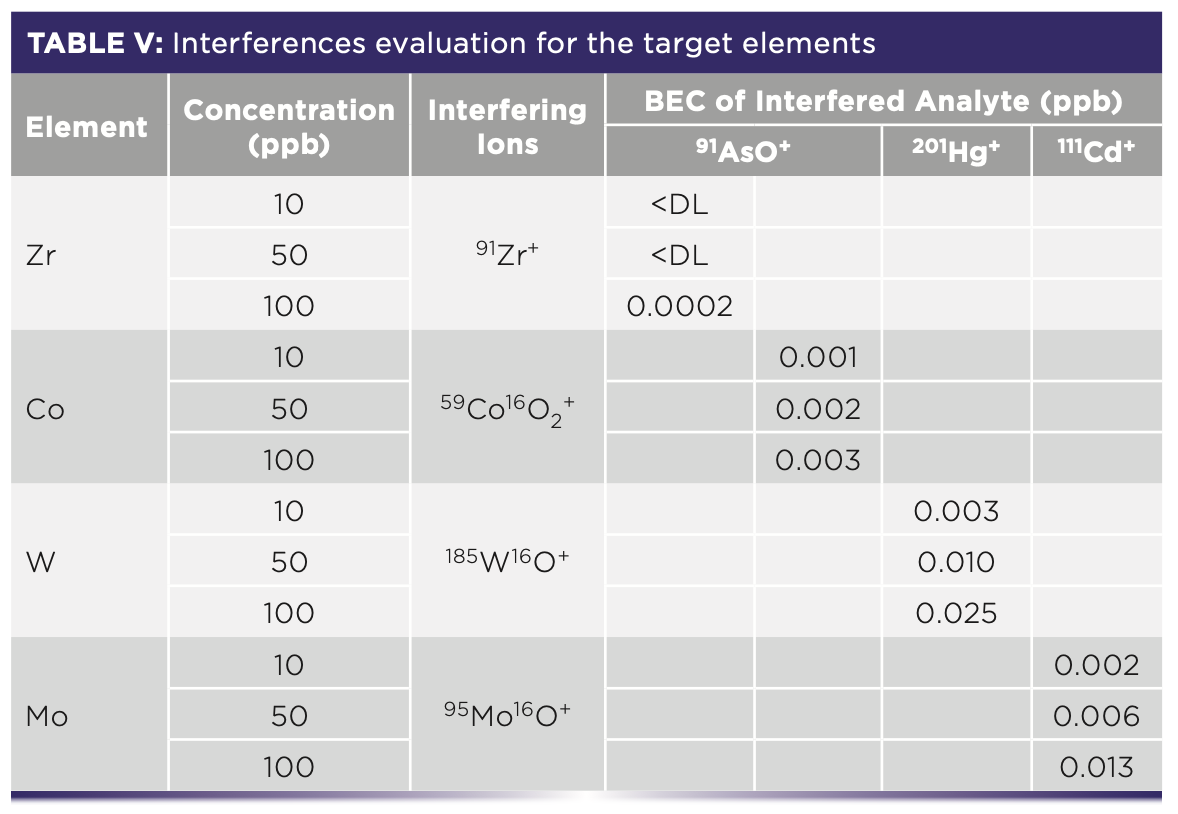
Lutetium (Lu) Digestion Spike
Recoveries higher than 85% were achieved for all digested samples, including matrix spikes, blanks, and blank spikes, meeting the acceptance criteria (≥ 75%) as recommended in AOAC Table 2015.01F (2).
Detection Limits
The limit of quantification (LOQ) was calculated as 10 times the standard deviation of 10 replicated measurements of the method blank multiplied by the dilution factor.
A comparison of the LOQs achieved in this work and those provided in AOAC 2015.01 is shown in Figure 1. For all the target elements, the LOQs obtained in this work were lower than those of different food types published in AOAC Table 2015.01H.
FIGURE 1: Comparison of limits of quantification (LOQs) achieved in this work with those captured in AOAC Table 2015.01H (2).
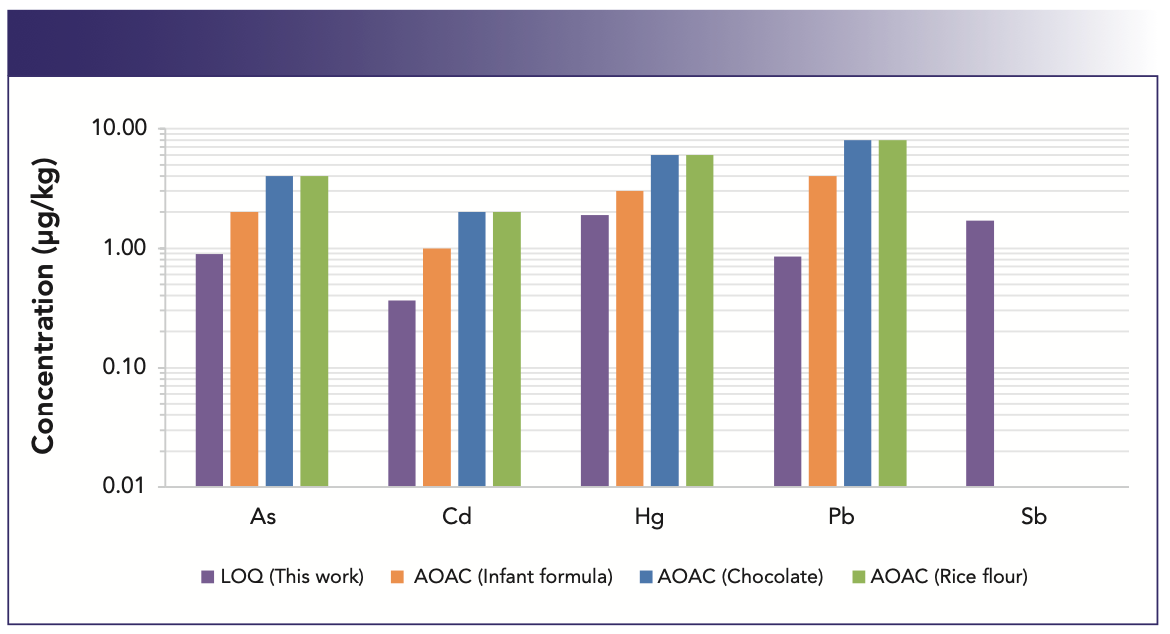
Accuracy
The accuracy was verified by evaluating the recoveries of various analytes achieved for the SRMs: NIST 1568b (rice flour), NIST 2976 (mussel tissues), CRM DORM-5 (fish protein), and the matrix spikes.
The CRMs and matrix spikes were prepared in duplicates, and each preparation was measured three times. The mean recoveries of the duplicates are shown in Figure 2. Recoveries between 85% and 114% were obtained for the certified elements, falling well within the QC criteria of 75–125% as provided in AOAC Table 2015.01F.
FIGURE 2: Recoveries for the certified elements in the CRMs.
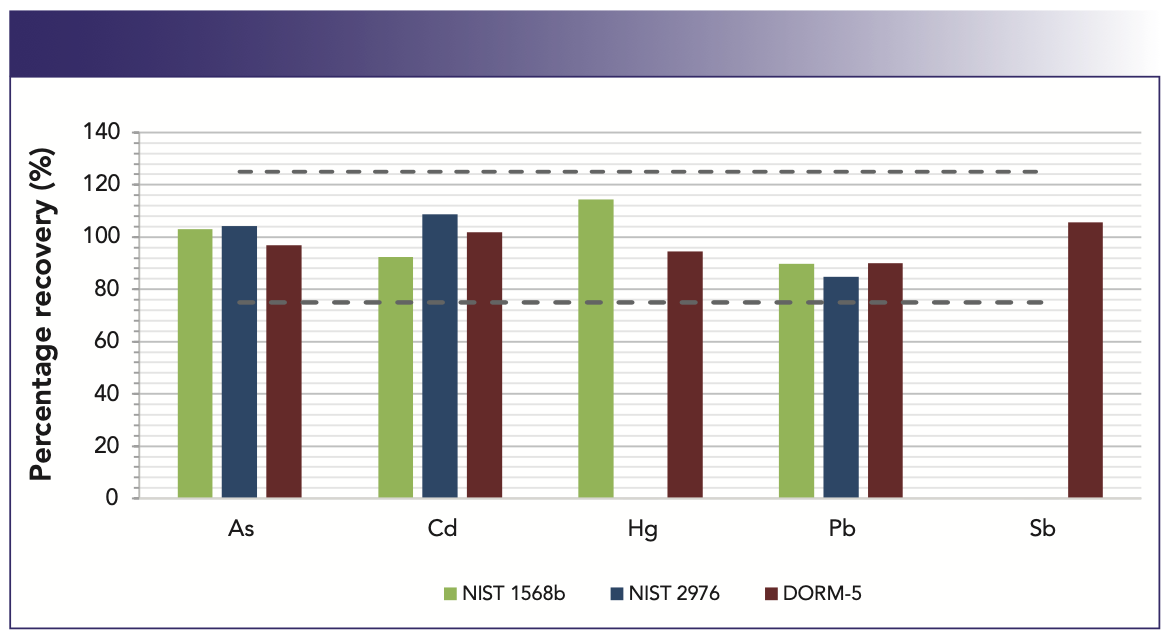
Matrix spikes were performed on three CRMs. Duplicates were prepared for each spiked sample. The mean recoveries are shown in Figure 3. Recoveries between 75% and 113% were obtained for all target elements, meeting the QC acceptance criteria of 70–130% as specified in AOAC Table 2015.01F.
FIGURE 3: Spike recoveries for the tested CRMs. *The recoveries of As for NIST 2976 and DORM-5 were not reported. The spike level in this case was too low (<5% of the intrinsic amount), resulting in higher errors.
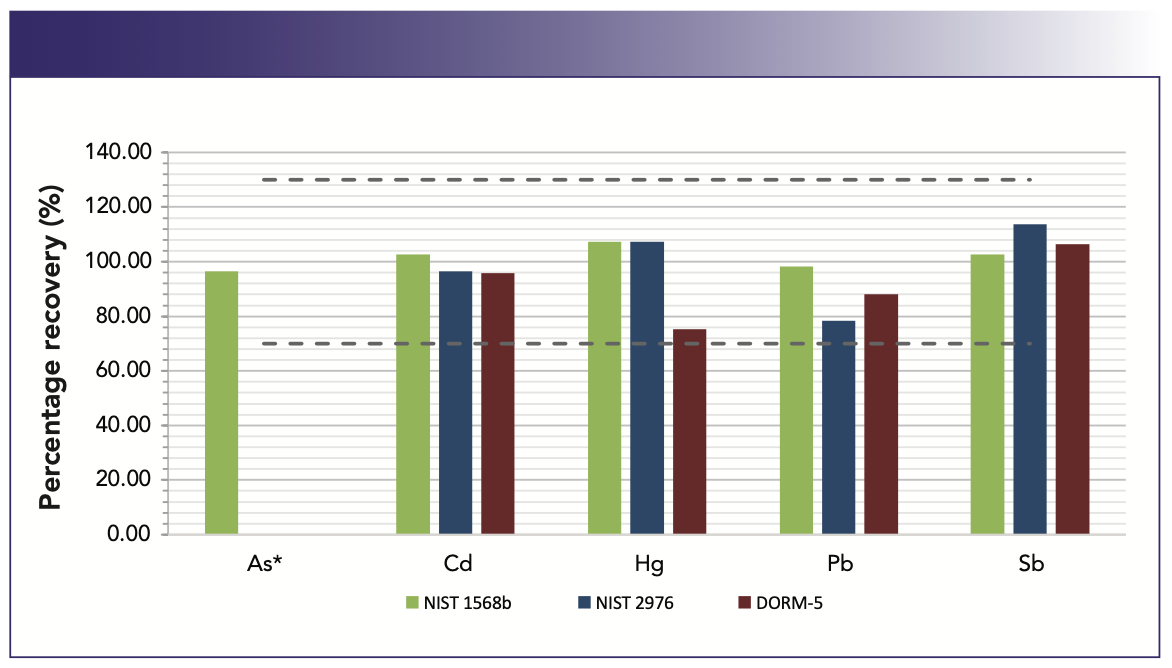
Precision
The precision was evaluated by the relative percent difference (RPD) of duplicated sample analysis. The duplicated samples were separately digested and went through the same sample preparation process as individual samples. These tests were performed on three CRMs. In all cases, the RPDs were within the QC acceptance criteria of <30% as specified in AOAC Table 2015.01F for all target elements, as shown in Table VI.
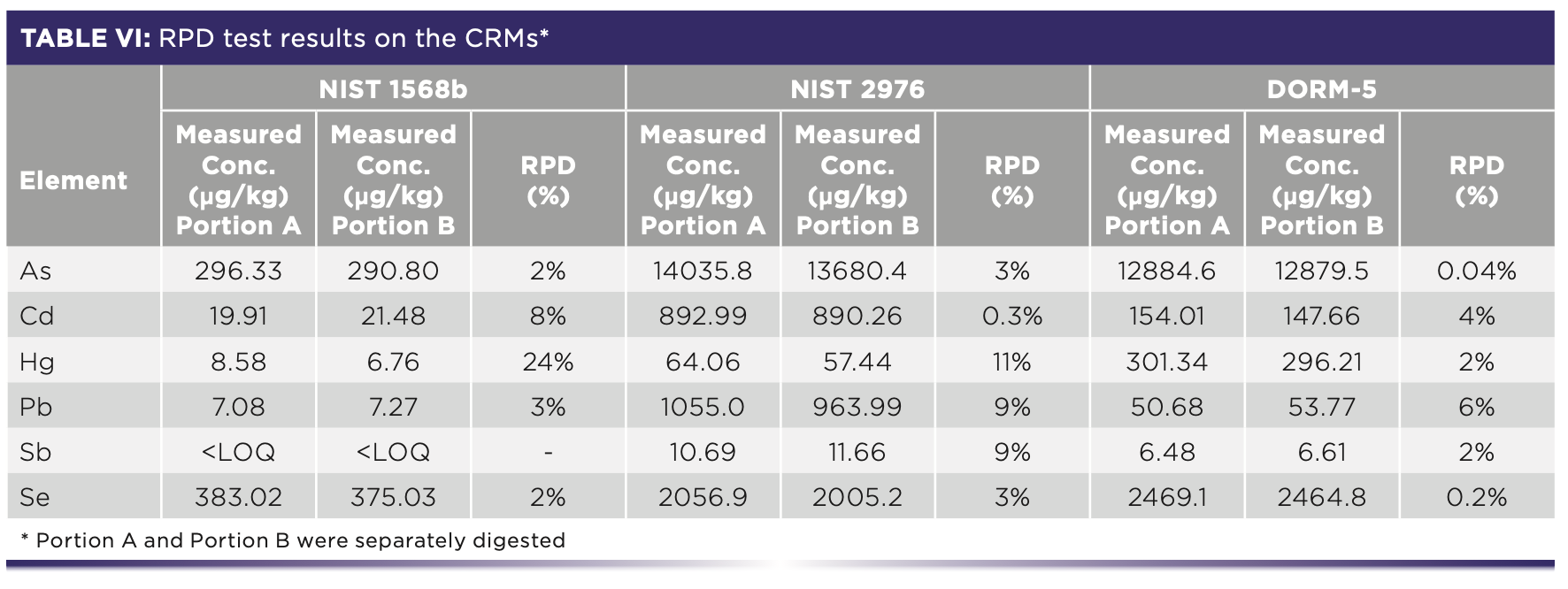
Stability Check
To validate the stability of the method, various food samples were measured repeatedly over 8 h , and the CCV recoveries were checked over this period. CCV was measured every 10–15 samples. All CCV recoveries were normalized to Standard 4 (Table III), and were well within ± 10% of the original reading, as shown in Figure 4, meeting the QC acceptance criteria of 85– 115% as specified in AOAC Table 2015.01F.
FIGURE 4: CCV recoveries over an 8-h run of food samples.
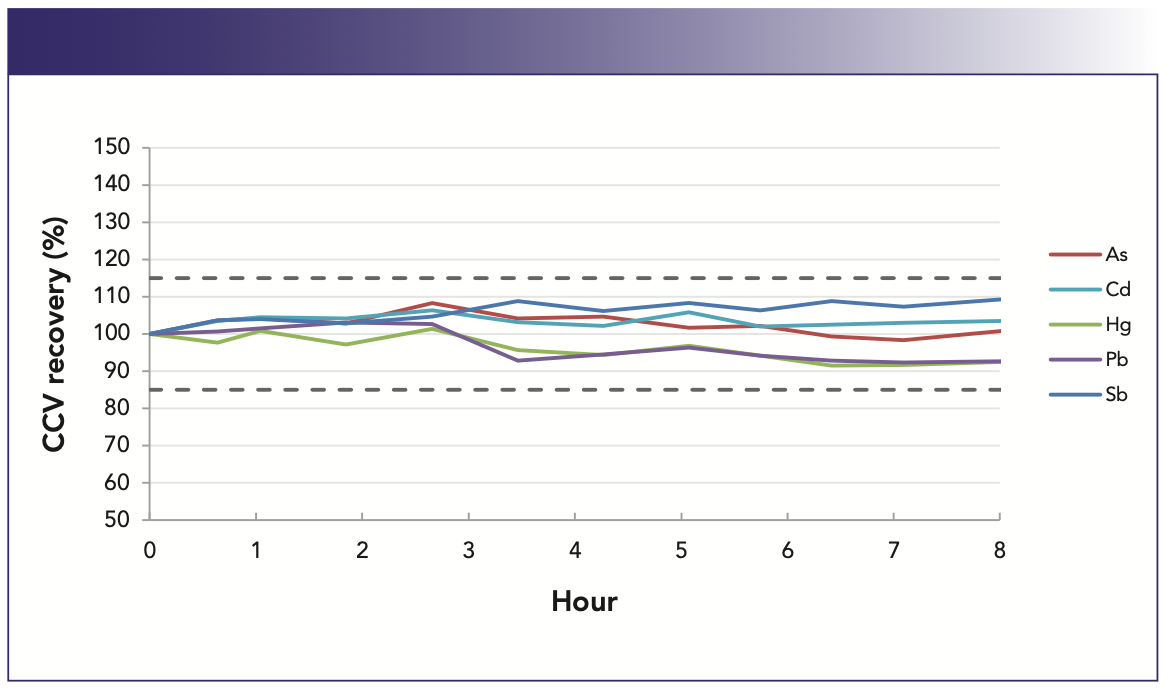
Conclusions
The method outlined in AOAC 2015.01 was validated with a commercially available ICP-MS instrument using both collision and reaction cell modes, automated sampling procedure, and microwave digestion system for the determination of the toxic elements As, Cd, Hg, Pb, and Sb in various food matrices. The study was evaluated for the LOQ, accuracy, precision, and stability. All the QC criteria were met or exceeded, showing the method suitability of this equipment in a routine laboratory environment.
References
(1) AOAC Official Method 2015.01; “Determination of Heavy Metals in Food by Inductively Coupled Plasma-Mass Spectrometry First Action” (2015).
(2) E. H. Larsen and S. Sturup, J. Anal. At. Spectrom. 9, 1099–1105 (1994).
(3) T. Ariga, Y. Zhu and K. Inagaki, J. Anal. At. Spectrom. 34, 1865–1874 (2019).
ABOUT THE AUTHOR
Liyan Xing is with PerkinElmer Inc., in Woodbridge, Ontario, Canada. She holds a Ph.D. in Analytical Chemistry and has specialized in elemental and isotope analysis using ICP-MS. Liyan is currently a national committee member of the Canadian Society for Analytical Sciences and Spectroscopy (CSASS) and the editor of the Society’s newsletter since 2019.

ABOUT THE COLUMN EDITOR
Robert Thomas, the editor of the “Atomic Perspectives” column, is the principal of Scientific Solutions, a consulting company that serves the educational and writing needs of the trace element analysis user community. Rob has worked in the field of atomic spectroscopy and mass spectrometry for more than 45 years, including 24 years for a manufacturer of atomic spectroscopic instrumentation. He has authored more than 100 scientific publications, including a 15-part tutorial series, “A Beginners Guide to ICP-MS.” In addition, he has authored five textbooks on the fundamentals and applications of ICP-MS. His most recent book, a paperback edition of Measuring Heavy Metal Contaminants in Cannabis and Hemp was published in December 2021. Rob has an advanced degree in analytical chemistry from the University of Wales, UK, and is a Fellow of the Royal Society of Chemistry (FRSC) and a Chartered Chemist (CChem). Direct correspondence to SpectroscopyEdit@mmhgroup.com ●

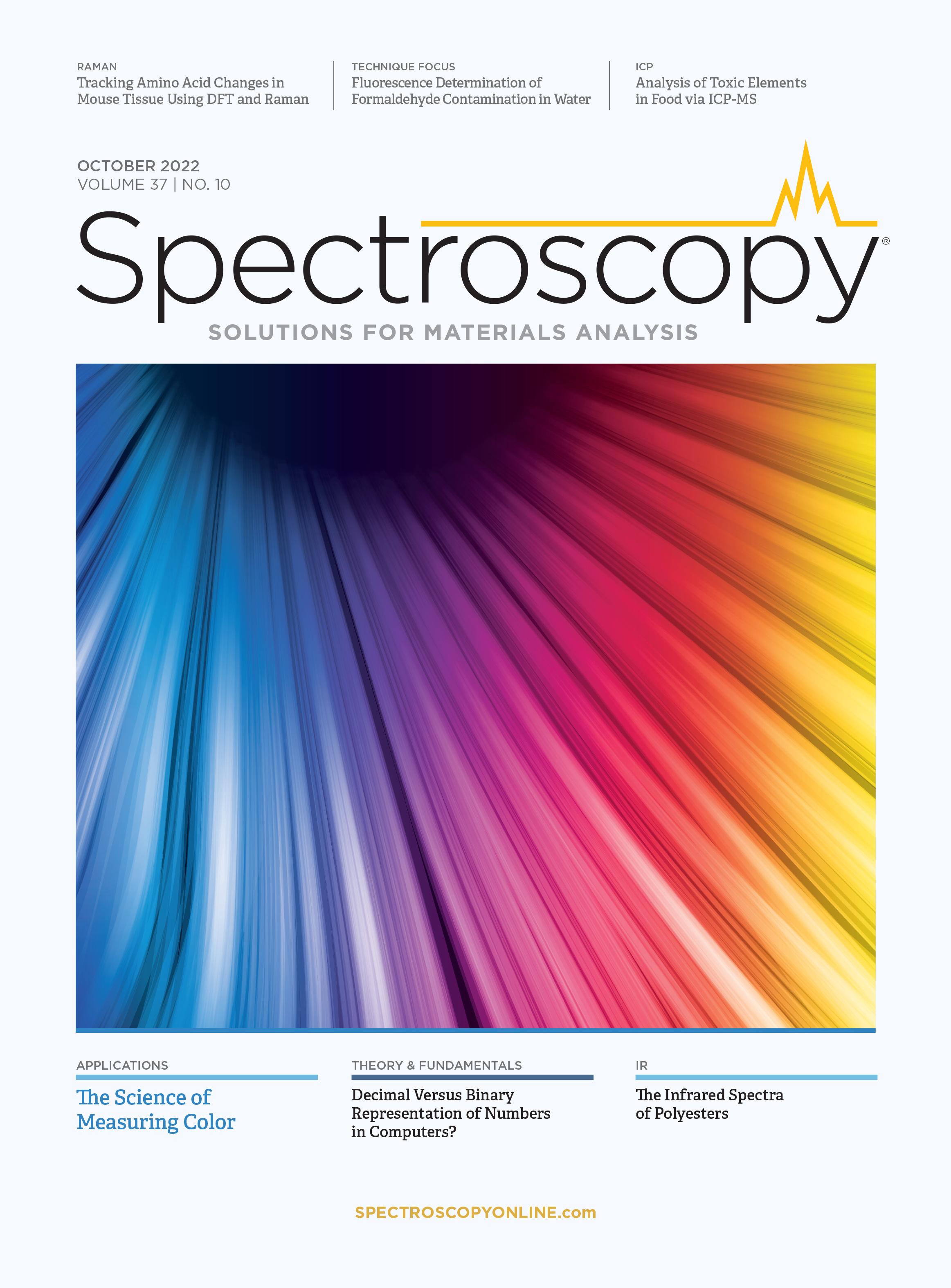
LIBS Illuminates the Hidden Health Risks of Indoor Welding and Soldering
April 23rd 2025A new dual-spectroscopy approach reveals real-time pollution threats in indoor workspaces. Chinese researchers have pioneered the use of laser-induced breakdown spectroscopy (LIBS) and aerosol mass spectrometry to uncover and monitor harmful heavy metal and dust emissions from soldering and welding in real-time. These complementary tools offer a fast, accurate means to evaluate air quality threats in industrial and indoor environments—where people spend most of their time.
NIR Spectroscopy Explored as Sustainable Approach to Detecting Bovine Mastitis
April 23rd 2025A new study published in Applied Food Research demonstrates that near-infrared spectroscopy (NIRS) can effectively detect subclinical bovine mastitis in milk, offering a fast, non-invasive method to guide targeted antibiotic treatment and support sustainable dairy practices.
New AI Strategy for Mycotoxin Detection in Cereal Grains
April 21st 2025Researchers from Jiangsu University and Zhejiang University of Water Resources and Electric Power have developed a transfer learning approach that significantly enhances the accuracy and adaptability of NIR spectroscopy models for detecting mycotoxins in cereals.